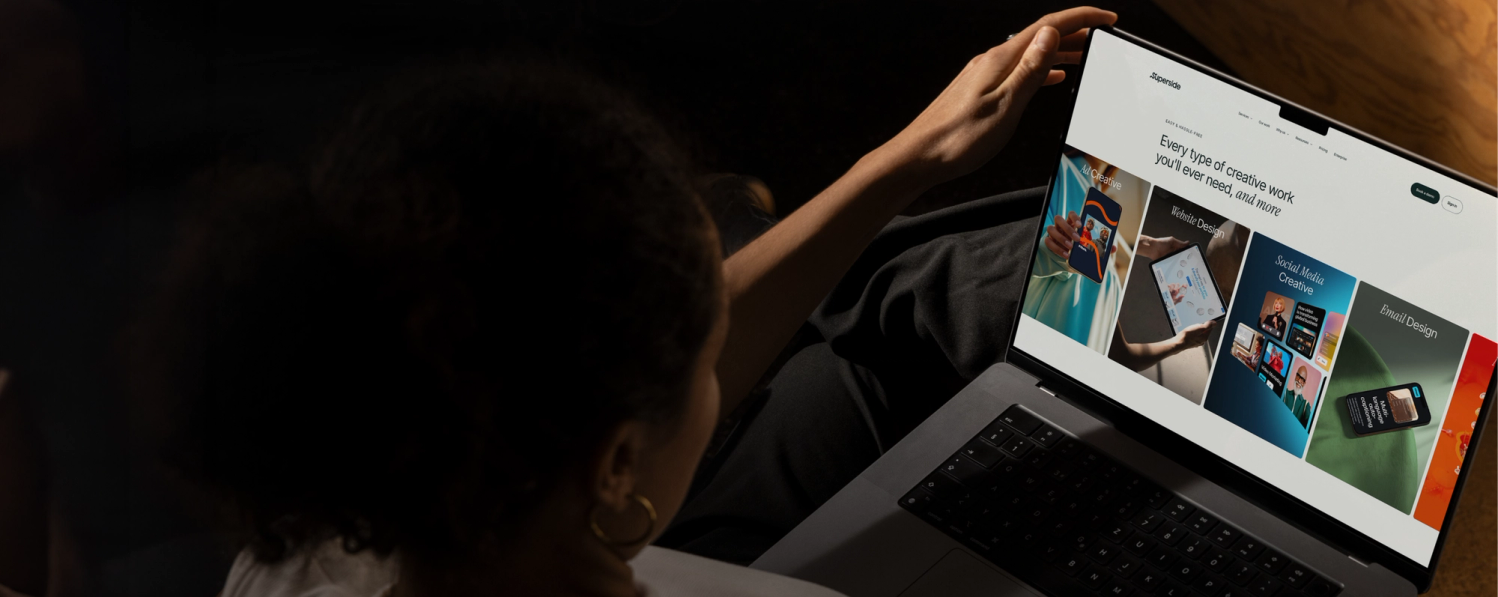13 Principles of Design: A Superside's Guide With Examples

Mastering design principles is essential for creating compelling visuals. Our comprehensive guide delves into 13 key principles—each explained to understand how they work and why they matter for all designing projects from scratch to finish.
Design is all around us—from the clothes we wear to how our cities are planned. But what exactly makes a design “good” and why do some designs captivate us while others leave us feeling indifferent? Is there a science behind the artistry, or is it purely about intuition?
This ultimate guide explores the elements and principles of design and showcases some notable graphic design examples that explicitly showcase them.
Ready for a design deep dive? Let's go.
Why Are There Principles of Design?
When it comes to creating visual designs, following established principles can help guide and inform the process, making it easier to nail best practices.
The reason why these principles are so important is how they help to create designs that are visually appealing, relatable, and effective in their goals. The principles of design are nothing new. In fact, they were established throughout the nineteenth century, primarily in Western Europe.
In truth, great design strikes a balance between creativity and structure. At its core are the elements and principles that guide how visuals communicate, resonate, and inspire.
13 Principles of Design
Whether you're a marketer looking to polish campaigns or just simply curious about what makes good design work, this guide has something for you. While there are a few main principles of design, each listed here has its place within the design process.
So, we decided to include them all! Here are all 13 principles of design with examples.
1. Emphasis
When it comes to design, there are a few basic principles that can help you create an effective and engaging composition. One of these principles is emphasis.
Emphasis is the process of making one element of a design stand out from the rest. This can be done through color, size, position or even with motion design.
The key is to use emphasis judiciously, as too much can be just as ineffective as too little. When used correctly, emphasis can help to guide the viewer's eye around a composition and highlight the most important elements. Just remember balance (see how we used emphasis there?) and you'll be well on your way to eye-catching design.
2. Balance
Like I mentioned above, one of the most important principles of design is balance. Balance can be achieved in a design by using different elements in equal amounts or by arranging elements so they counterbalance each other.
For example, a symmetrical design is balanced because the left side mirrors the right side. Another example would be a design with a large element on one side and several small elements on the other side. The key is to create a sense of visual stability so that the viewer's eye is not drawn to one particular area.
Artists and designers can create harmonious and pleasing compositions by carefully considering balance. Below is a great example of balance from one of Superside's very own.
3. Contrast
Contrast holds a special place among the principles of design. It refers to the use of distinct elements to create visual interest and break up the monotony. Contrast can be created through the use of color, shape, size, and texture.
For example, a room with walls painted in a light color will feel brighter and more spacious than a room with dark-colored walls. Similarly, a room with furniture in different shapes and sizes will feel more dynamic than a room with matching furniture.
By employing contrast in design, you can add visual interest to any space. It is also important that you select accessible colors that sufficiently contrast, especially in regard to text and its background, so people with certain vision impairments can also benefit from it.
4. Repetition
In design, repetition is used to create a sense of rhythm and flow.
By repeating certain elements, designers can add visual interest and create a cohesive design. The human brain is hardwired to look at patterns, and repetition done tactfully can leverage that instinct. In addition, repetition can also be used to convey a sense of movement or energy.
For example, by repeating a flowing pattern throughout a design, designers can suggest the motion of water or wind. In short, repetition is a versatile tool that can be used to add rhythm, harmony, and visual interest to any design.
4. Repetition
In design, repetition is used to create a sense of rhythm and flow...just kidding. Moving on....
5. Proportion
Proportion refers to the relationships between various elements in a composition. The most common way to think of proportion is in terms of size, but it can also refer to other attributes such as color, shape, and texture.
When elements are in harmony with one another, they are said to be in proportion. This can create a sense of balance and stability, making a composition feel harmonious and unified.
On the other hand, when elements are out of proportion with one another, it can create a sense of discord and disharmony. As a result, graphic designers must carefully consider proportion when creating any kind of composition.
6. Movement
In the world of design, movement is all about creating a sense of flow and visual interest. By leading the eye around an image or object, designers can control how a viewer experiences a piece.
In general, there are three main ways to create movement: repetition, contrast and hierarchy. By repeating elements such as shapes, colors or patterns, designers can create a visual rhythm that encourages viewers to keep moving forward.
Contrast can also be used to create movement, for instance, by placing light elements against dark backgrounds or vice versa. Hierarchy can be used to guide the eye from the most important elements to the least important ones.
By understanding these principles, designers lead their viewers around a piece, allowing them a subtle authority over the experience of viewers.
7. White Space
White space (also known as negative space) is the area around the subject in a design and can be used to create balance, contrast, and visual interest.
Sometimes, designers try to cram too much into a design, resulting in a cluttered and busy-looking mess. By making use of white space, designers can create compositions that are clean and eye-catching.
White space can also highlight certain elements of a design or create a sense of motion. When used well, white space can take a design from good to great. Don't be afraid of some blank space–it could be the key to making a design truly stand out. Here's an example from Superside that's not afraid of a little negative space:
8. Rhythm
The principle of rhythm is all about creating a sense of movement. In design, this can be accomplished by repeating elements, such as patterns or shapes.
When used effectively, rhythm can help to guide the eye around a design and create a sense of flow, and define the pace at which the design should be experienced.
Also, rhythm can also be used to convey a feeling or mood. For example, a design with a fast-paced rhythm may feel energetic and exciting, while a slow and steady rhythm may convey a feeling of calmness and relaxation.
9. Pattern
Patterns are a basic element of design and can be found in both natural and artificial objects. In nature, patterns often occur as a result of the repeating shape of leaves or petals, the stripes on a zebra, or the ripples in sand dunes.
Manufactured patterns are often more geometric in nature, such as the checkerboard pattern of a chessboard or the stripes on a candy cane. In design, patterns can be used to create visual interest, add texture, or emphasize a certain area.
They can also be used to convey information, such as in a barcode or QR code. Patterns can be created using a variety of media, including paint, fabric, paper, or even concrete. When used effectively, patterns can add depth and dimension to any design.
10. Hierarchy
There are different ways to organize information visually. One common approach is called "hierarchy."
Generally, the idea is to arrange things to give prominence to the most important or noteworthy elements. This can be done in multiple ways, such as using different fonts, sizes or colors.
When done well, hierarchy can help to make information more understandable and easier to process. However, it's important not to go overboard, as too much emphasis on one element can create a cluttered and confusing design. Instead, the goal is to strike a balance that allows all the important elements to stand out in their own way.
11. Variety
Too much of anything (even if it’s good) makes for a negative experience, as anyone who’s overeaten can relate to. That's especially true when it comes to design.
An effective design must strike a balance between familiarity and novelty, giving viewers enough visual interest to keep them engaged without overwhelming them with too much information. This is where variety comes in.
By incorporating a number of different elements into a design, we can create a harmonious balance that is both visually appealing and easy to understand. The 13 principles of design are like the ingredients in a recipe–each one plays an important role in creating a finished product that is both visually appealing and functional.
12. Unity
The principle of unity in design means creating a sense of coherence or overall harmony. In other words, all the elements in a design should work together to create a cohesive whole.
This can be achieved using similar colors, shapes, or textures; repeating elements throughout the design; or using a unifying element, such as a central motif. When unity is successful, the viewer should feel that the design is balanced and organized, with no random or misplaced elements.
However, too much unity can result in a boring or “flat” design, so it’s important to find the right balance. By understanding and applying the principle of unity, you can create designs that are pleasing to the eye and easy to understand.
13. Harmony
Harmony is the use of similar elements to create a cohesive and pleasing whole. Harmony can be achieved through the use of repetition, rhythm and pattern.
Repeating elements helps to create a sense of unity, while rhythm and pattern can add visual interest and variety. When used effectively, harmony can help to achieve a sense of balance and calm in a design.
However, too much harmony can result in a design that feels monotonous or bland. As with all principles of design, the key is to find the right balance for the specific project you are working on.
Principled Design Makes All the Difference
In design, elements and principles work together to create a cohesive whole. Unity, variety, harmony and hierarchy are some of the most important principles to understand in order to create an effective design.
These principles can add visual interest, balance and coherence to any project when used correctly to make an actual impact.
If you're in need of designers who live out these principles in their work every single day, take a look at our broad range of graphic design services on offer.















